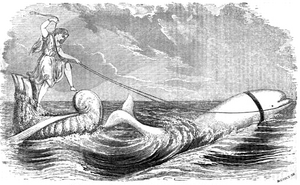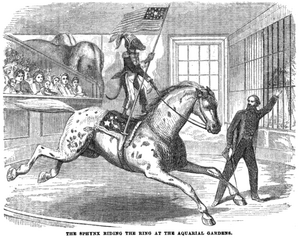Boston Aquarial and Zoological Gardens facts for kids
The Boston Aquarial and Zoological Gardens was a cool place in Boston, Massachusetts, USA, that had both an aquarium and a zoo. It was open for a short time, from October 1860 to June 1862. You could find it in the Financial District on Central Court, near Washington Street. Inside, there were "hundreds of fish swimming in their natural home" and lots of other animals too!
The business was started by James Ambrose Cutting and Henry D. Butler. It grew out of an earlier place called the Boston Aquarial Gardens. Later, in 1862, the famous showman P.T. Barnum bought it. He fixed it up and opened it again as Barnum's Aquarial Gardens.
| Date opened | October 1860 |
|---|---|
| Date closed | June 1862 |
| Location | Boston, Massachusetts, USA |
| Coordinates | 42°42′39″N 73°01′11″W / 42.7109°N 73.0198°W |
Contents
History of the Gardens
The Boston Aquarial and Zoological Gardens first opened its doors on October 5, 1860. The zoo part had new animals like a moose, a leopard, a big African python, and several seals. Tickets cost 25 cents for adults and 10 cents for kids.
By February 1861, the aquarium had grown a lot. It showed off a new type of sea anemone called Trochartea pendula. The aquarium also had eels, trout, haddock, shrimp, and dogfish.
Downstairs, in the zoo area, an alligator shared a space with different turtles and an African ibis bird. There were also lions, a leopard, a grizzly bear, black bears, and many kinds of monkeys and parrots. You could see an albino flying squirrel, deer, owls, and foxes. The "den of serpents" was home to an anaconda, pythons, and other snakes. In 1861, Uriah Sears was in charge of the zoo animals. He trained the bears, kangaroos, moose, and a baboon to do amazing tricks in a special ring.
The Famous Whale
In 1861, the owners brought in a live beluga whale. This was a very big deal! It was the first cetacean (a type of marine mammal like whales and dolphins) ever kept in a modern aquarium.
The whale was caught in the St. Lawrence River in Canada. Fishermen used special traps made of wooden stakes to catch it. The whale was very strong and gave them a lot of trouble! It flapped and jumped, even knocking over some of the Frenchmen trying to catch it.
Once caught, the whale was put into a huge box lined with seaweed. It was then carried seven miles over a rough road. After that, it traveled 500 miles by special train to Boston. During the 60-hour journey, the whale was kept wet at every train station, just like a locomotive needing water. Everyone along the way was very curious about this special traveler. When the whale finally arrived at the Aquarial Gardens, hundreds of people watched as it was carefully placed into its giant tank. The whale immediately started swimming in a lively and graceful way!
Years later, by 1869, the skeleton of this famous whale was given to the Museum of Comparative Zoology by Mr. Cutting.
The "Sphinx" Animal
Visitors could also see an animal called a "sphinx." This wasn't the mythical creature, but a real animal that was trained to perform. When it first arrived, it was described as dull and stubborn. But it became one of the biggest attractions!
The sphinx was amazing at riding horses. It would appear with a flag or act like a "fast young man" on a rented horse. Its other performances in the ring were very funny. It could push a wheelbarrow, act lazy, pretend to be unconscious, carry a heavy log, climb a pole, and even travel around the ring on the handrail.
P.T. Barnum Takes Over
In 1862, the famous showman P.T. Barnum bought the Aquarial and Zoological Gardens. He closed it for a while to make many improvements. When it reopened as Barnum's Aquarial Gardens, Barnum announced that it would be connected to his famous American Museum in New York.
Barnum wanted the Gardens to be a place where people could have fun and learn at the same time. He hoped it would attract not just scientists, but everyone. James Cutting, one of the original owners, stayed on to take care of the whale, seals, and other rare animals.
Past Events
- 1860
- 1861
- January - Professor Harrington, a local favorite, showed off his amazing ventriloquism skills.
- March - A play called "The Robbers of Bagdad, or the Fairy Police" was performed. After the play, animals like the Arabian horse Abdallah, the sphinx, the trained bear, the moose, and the kangaroos did their tricks in the ring. The seals, Ned and Fanny, also performed.
- April - "An Hour in Olympus, or, a Glance at the Gods" premiered. This was a big show with music, mythology, and pantomime.
- A living white or Beluga whale was on display. It was 12 feet long and weighed 2,000 pounds. It was brought from the Gulf of St. Lawrence and was the only one ever caught alive and kept in captivity.




